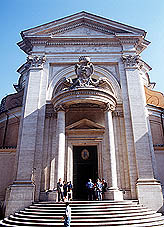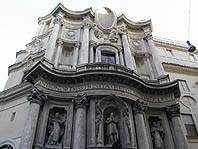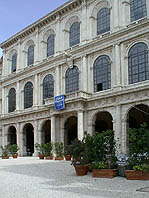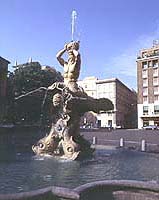A Walkabout Baroque
Bernini vs Borromini
One of the inexhaustible games one can play in Rome is "Bernini or Borromini - who's Mr. Baroque?"
Everybody in Rome, has a strong opinion on this burning topic.
Even two days of sightseeing in Rome entitles you to take sides and challenge any contrary opinion.
These two supreme architects of Rome's Baroque splendors were born within a year of each other, started their professional lives as friends working side by side on lavish building projects, but were soon turned into bitter enemies by fierce competition for architectural commissions.
They converged on Rome from opposite ends of Italy, reflecting the diverse characters of their regions: the Southerner, Bernini (1598-1680), was an exuberant Neapolitan, whereas the Northerner, Borromini (1599-1667), was a dour Lombard.
Borromini, wracked with paranoia, finally killed himself, vilifying his rival in his final years, as he saw Bernini becoming ever more famous while he himself was unknown, unsung and usually unemployed.
In his own time, especially as he outlived and out-produced his Northern competitor, Bernini would have gotten the most votes, but today Borromini has at least tied, if not out-polled, his Southern rival.
You can decide who you prefer by visiting some masterpieces of both in an easy hour's walkabout.
St. Andrea al Quirinale
 Reputedly his favorite original building (1658-1671), Bernini turned religious architecture 90 degrees by laying out this small church as a rounded oval with the longest dimension stretching sideways and the short axis leading from the entrance door to the high altar.
Reputedly his favorite original building (1658-1671), Bernini turned religious architecture 90 degrees by laying out this small church as a rounded oval with the longest dimension stretching sideways and the short axis leading from the entrance door to the high altar.
The facade, recessed in a curved proscenium for dramatic effect, is made up entirely of classical architectural elements: Greek egg-and-dart motif, Corinthian pilasters, Roman half circles and triangles.
They are, however, squeezed into a vertically elongated shape and dominated by a large escutcheon of papal prince Camillo Pamphili who commissioned the church.
The interior, known as "the pearl of the Baroque", is an almost Rococo dramatic play of light and shade.
Rising toward the soaring dome is a sculpted ensemble with a crucified St. Andrew over the altar looking up toward an effigy of himself ascending into heaven. Heaven.
 Thanks to Bernini, his then mentor, Borromini got his first commission: to design a monastery and church on a tiny plot of land for an obscure religious order, the Spanish Discalced Trinitarians.
Thanks to Bernini, his then mentor, Borromini got his first commission: to design a monastery and church on a tiny plot of land for an obscure religious order, the Spanish Discalced Trinitarians.
Perhaps no church (1634-1667) in the world so clearly demonstrates the pulsating drama of movement that is the objective of Baroque architecture.
From the outside you cannot imagine what the inside might be like since every part of the facade is undulating S-curves except the door.
The entrance is in the central bay, which curves forward in a convex line and then flows into concave bays on either side.
The eye never comes to rest on any dominant element as it would on a flat Renaissance wall. The interior is shaped like an oval football pinched in at its four corners.
The dome above is less a reflection of the floor below than a explosion into the firmament.
Like all Borromini churches, the interior is pure white. Its entire form would fit into one of the piers supporting the dome of St. Peter's.
Be sure to come at a time when you can visit the adjoining monastic cloister where Borromini demonstrates his devotion to Michelangelo's Mannerist style by such subtle, disturbing tricks as having no columns in the four corners - the weight of the upper story is carried by pairs of columns topped with arches that seem more concerned with providing openings than with weight-bearing.
Quattro Fontane
To highlight the giant cross made up of two streets (Via del Quirinale and Via Quattro Fontane) Sixtus V asked Domenico Fontana to design something artistic.
The Pope, town-planner extraordinary, had already marked with obelisks the extremities of this street-cross, in front of the Palazzo del Quirinale, behind St. Maria Maggiore and at the top of the Spanish Steps - with Porta Pia marking the base.
Fontana (aptly named) placed fountains at the four corners of this crossroads: representing the
rivers Arno and Tiber and the Goddesses Diana and Juno.
Palazzo Barberini
 The entrance to the wing on the left will bring you to Bernini's giant square staircase. Borromini's smaller oval staircase is just inside the entrance to the right wing.
The entrance to the wing on the left will bring you to Bernini's giant square staircase. Borromini's smaller oval staircase is just inside the entrance to the right wing.
Borromini had been working as chief assistant to the original architect of the palazzo, Carlo Maderno, who, along with Michelangelo, he considered his inspiration.
The 31 year-old prodigy Bernini took over on Maderno's death and inherited Borromini, who was barely a year younger. Bernini was the most talented sculptor and decorator of his day, but knew little of architecture and had to rely on Borromini to solve the problems that such an immense construction presented.
The square staircase is certainly impressive as it thrusts around 90-degree turns, but the subtlety of the rounded oval stairway demonstrates Borromini's ability to endow small spaces with monumentality.
Outside, as you look at the main facade, notice the details of Borromini's windows on the top floor: the seven central ones are topped by false-perspective arches to look as if the windows were set far back into the building; the smaller windows, one on either side of those seven, broke with all previous architecture by combining flat and rounded elements on top of the window in the pediment - the ends of which thrust out diagonally from the building like birds' wings.
This palazzo may represent that glorious moment when the two artists worked in harmony.
The Palazzo also house the Galleria Nazionale d'Arte Antica in some of the great rooms, with a permanent collection of fine paintings such as Raphael's "Fornarina", Holbein's portrait of "Henry VIII".
 Just down the hill from Palazzo Barberini is the piazza of the same name, dominated by the famous Tritone Fountain ("Fontana del Tritone", 1642).
Just down the hill from Palazzo Barberini is the piazza of the same name, dominated by the famous Tritone Fountain ("Fontana del Tritone", 1642).
Here Bernini broke with tradition by excluding virtually all architectural elements and creating a purely sculptural fountain.
The merman (or triton) is blowing a high spout of water out of his conch shell while kneeling on two scallop shells held up by four dolphins.
At the corner of Via Veneto, Bernini's "Fountain of the Bees" ("Fontana delle Api", 1644) honors his patron Pope Urban VIII Barberini whose family symbol was, appropriately for such a busy swarm, the bee. It features three giant insects crossing a scallop shell to drink at the large fountain.
![]() YOUR CHOICE? Stand in this vast square. Glance up the Via delle Quattro Fontane at the corner of Borromini's Church of San Carlo.
YOUR CHOICE? Stand in this vast square. Glance up the Via delle Quattro Fontane at the corner of Borromini's Church of San Carlo.
Study the two glorious Bernini fountains. Look up at the Palazzo Barberini hovering above the square. Dream that you are a 17C cardinal and favorite nephew of the Pope having to decide: who will be your family architect: Bernini or Borromini? Or, why not both?